Deck 3: Gene Control of Proteins
Question
Question
Question
Question
Question
Question
Question
Question
Question
Question
Question
Question
Question
Question
Question
Question
Question
Question
Question
Question
Question
Question
Question
Question
Question
Question
Question
Question
Question
Question
Question
Question
Question

Unlock Deck
Sign up to unlock the cards in this deck!
Unlock Deck
Unlock Deck
1/33
Play
Full screen (f)
Deck 3: Gene Control of Proteins
1
Most enzymes are proteins, but not all proteins are enzymes. What are the functions of enzymes, and why are they essential for living organisms to carry out their biological functions?
Enzymes are proteins that catalyze biochemical reactions in various cellular processes. Catalyze means to lower the energy of activation of a chemical reaction. By lowering the energy of activation of a reaction, an enzyme allows a reaction to occur more quickly than it would under normal cellular conditions. Some enzymes work by moving substrates closer together, in a particular manner, so they react to create products.
Enzymes are essential for living organisms to carry out their biological functions because otherwise it would take much longer for reactions to occur and cells would not be able to live or function. Without enzymes, major cellular processes would have to occur spontaneously which would not be likely to happen.
Enzymes are essential for living organisms to carry out their biological functions because otherwise it would take much longer for reactions to occur and cells would not be able to live or function. Without enzymes, major cellular processes would have to occur spontaneously which would not be likely to happen.
2
What was the significance of Archibald Garrod's work, and why do you expect that it was not appreciated by his contemporaries?
Archibald Garrod studied the disease alkaptonuria, a human disease in which the urine turns black. Garrod studied human pedigrees and proposed that alkaptonuria is a homozygous recessive disease. In humans, most traits are influenced by at least two alleles on homologous chromosomes, one from the father and one from the mother. In a homozygous recessive disease, an individual has inherited the recessive mutant allele from both parents, which causes the disease.
Garrod observed that people with alkaptonuria excrete homogenistic acid (HA) which is not present in the urine of unaffected individuals. He hypothesized that unaffected individuals must be able to metabolize HA, while people who suffer from alkaptonuria do not. Garrod surmised that people with alkaptonuria had a nonfunctional or mutated enzyme that would metabolize HA. The work of Garrod provided evidence of a relationship between enzymes and genes.
Additionally, Garrod was able to conclude that if a metabolic pathway is blocked it is indicated by an accumulation of the compound meant to be the substrate of the blocked step.
Garrod's work was not appreciated by his contemporaries. The lack of appreciation might have been due to the lack of belief that an accumulated compound in an individual's cells could indicate a genetic mutation and possibly a disease.
Garrod observed that people with alkaptonuria excrete homogenistic acid (HA) which is not present in the urine of unaffected individuals. He hypothesized that unaffected individuals must be able to metabolize HA, while people who suffer from alkaptonuria do not. Garrod surmised that people with alkaptonuria had a nonfunctional or mutated enzyme that would metabolize HA. The work of Garrod provided evidence of a relationship between enzymes and genes.
Additionally, Garrod was able to conclude that if a metabolic pathway is blocked it is indicated by an accumulation of the compound meant to be the substrate of the blocked step.
Garrod's work was not appreciated by his contemporaries. The lack of appreciation might have been due to the lack of belief that an accumulated compound in an individual's cells could indicate a genetic mutation and possibly a disease.
3
Phenylketonuria (PKU) is an inherited human metabolic disorder whose effects include severe mental retardation and death. This phenotypic effect results from
A) the accumulation of phenylketones in the blood.
B) the absence of phenylalanine hydroxylase.
C) a deficiency of phenylketones in the blood.
D) a deficiency of phenylketones in the diet.
A) the accumulation of phenylketones in the blood.
B) the absence of phenylalanine hydroxylase.
C) a deficiency of phenylketones in the blood.
D) a deficiency of phenylketones in the diet.
Phenylketonuria (PKU) is an autosomal recessive disease. Autosomal indicates the genetic mutation occurs on chromosome that is not a sex chromosome. PKU is a disease marked by an accumulation of phenylalanine.
Phenylalanine is an amino acid that is essential to humans. It must be ingested for necessary cellular processes, such as the synthesis of proteins; however an excess of phenylalanine is harmful to humans so a metabolic pathway exists to convert it to tyrosine, another amino acid.
Individuals with PKU do not have the enzyme that converts phenylalanine to tyrosine. Thus, they have an accumulation of phenylalanine which is then converted to phenylpyruvic acid. This product negatively affects the cells of the central nervous system and can cause mental retardation.
Choice (a) is incorrect because the phenotypic effect of PKU is caused by an accumulation of phenylpyruvic acid which is not a phenylketone.
Choice (c) is incorrect because the phenotypic effect of PKU is caused by an accumulation of phenylpyruvic acid. Also an autosomal recessive disease that creates a metabolic disorder is usually characterized by an accumulation of the compound that precedes the blocked step, not a deficiency.
Choice (d) is incorrect because the phenotypic effect of PKU is caused by an accumulation of phenylpyruvic acid. Also an autosomal recessive disease that creates a metabolic disorder is usually characterized by an accumulation of the compound that precedes the blocked step, not a deficiency.
Choice (b) is the correct answer because the phenotypic effect of PKU is cause by an accumulation of phenylpyruvic acid. This accumulation is caused by an accumulation of phenylalanine because of the absence of an enzyme that metabolizes it to tyrosine. Choice (b) is correct because it indicates the absence of an enzyme that hydroxylates phenylalanine.
Hence the correct answer is choice (b) the absence of phenylalanine hydroxylase.
Phenylalanine is an amino acid that is essential to humans. It must be ingested for necessary cellular processes, such as the synthesis of proteins; however an excess of phenylalanine is harmful to humans so a metabolic pathway exists to convert it to tyrosine, another amino acid.
Individuals with PKU do not have the enzyme that converts phenylalanine to tyrosine. Thus, they have an accumulation of phenylalanine which is then converted to phenylpyruvic acid. This product negatively affects the cells of the central nervous system and can cause mental retardation.
Choice (a) is incorrect because the phenotypic effect of PKU is caused by an accumulation of phenylpyruvic acid which is not a phenylketone.
Choice (c) is incorrect because the phenotypic effect of PKU is caused by an accumulation of phenylpyruvic acid. Also an autosomal recessive disease that creates a metabolic disorder is usually characterized by an accumulation of the compound that precedes the blocked step, not a deficiency.
Choice (d) is incorrect because the phenotypic effect of PKU is caused by an accumulation of phenylpyruvic acid. Also an autosomal recessive disease that creates a metabolic disorder is usually characterized by an accumulation of the compound that precedes the blocked step, not a deficiency.
Choice (b) is the correct answer because the phenotypic effect of PKU is cause by an accumulation of phenylpyruvic acid. This accumulation is caused by an accumulation of phenylalanine because of the absence of an enzyme that metabolizes it to tyrosine. Choice (b) is correct because it indicates the absence of an enzyme that hydroxylates phenylalanine.
Hence the correct answer is choice (b) the absence of phenylalanine hydroxylase.
4
If a person were homozygous for both PKU and alkaptonuria (AKU), would you expect him or her to exhibit the symptoms of PKU, AKU, or both? Refer to the following pathway: 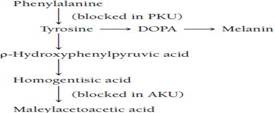


Unlock Deck
Unlock for access to all 33 flashcards in this deck.
Unlock Deck
k this deck
5
Refer to the pathway shown in Question. What effect, if any, would you expect PKU or AKU to have on pigment formation? Explain your answer.
Question
If a person were homozygous for both PKU and alkaptonuria (AKU), would you expect him or her to exhibit the symptoms of PKU, AKU, or both? Refer to the following pathway: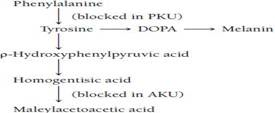
Question
If a person were homozygous for both PKU and alkaptonuria (AKU), would you expect him or her to exhibit the symptoms of PKU, AKU, or both? Refer to the following pathway:


Unlock Deck
Unlock for access to all 33 flashcards in this deck.
Unlock Deck
k this deck
6
Define the term autosomal recessive mutation , and give some examples of diseases that are caused by autosomal recessive mutations. Explain how two parents who display no symptoms of a given disease (albinism or any of the diseases you have named) can have two or even three children who have the disease. How can these same parents have no children with the disease?

Unlock Deck
Unlock for access to all 33 flashcards in this deck.
Unlock Deck
k this deck
7
Consider sickle-cell anemia as an example of a devastating disease that is the result of an autosomal recessive genetic mutation on a specific chromosome. Explain what a molecular or genetic disease is. Compare and contrast this disease with a disease caused by an invading microorganism such as a bacterium or virus.

Unlock Deck
Unlock for access to all 33 flashcards in this deck.
Unlock Deck
k this deck
8
A breeder of Irish setters has a particularly valuable show dog that he knows is descended from the famous bitch Rheona Didona, who carried a recessive gene for atrophy of the retina. Before he puts the dog to stud, he must ensure that it is not a carrier of this allele. How should he proceed?

Unlock Deck
Unlock for access to all 33 flashcards in this deck.
Unlock Deck
k this deck
9
As geneticists, what problems might we encounter if we accept the one-gene-one-enzyme hypothesis as completely accurate? What further information have we discovered about this hypothesis since its formulation? What work led to that discovery?

Unlock Deck
Unlock for access to all 33 flashcards in this deck.
Unlock Deck
k this deck
10
Upon infection of E. coli with bacteriophage T4, a series of biochemical pathways result in the formation of mature progeny phages. The phages are released after lysis of the bacterial host cells. Suppose that the following pathway exists: 
Suppose also that we have two temperature-sensitive mutants that involve the two enzymes catalyzing these sequential steps. One of the mutations is cold sensitive ( cs ), in that no mature phages are produced at 17°C. The other is heat sensitive ( hs ), in that no mature phages are produced at 42°C. Normal progeny phages are produced when phages carrying either of the mutations infect bacteria at 30°C. However, let us assume that we do not know the sequence of the two mutations. Two models are therefore possible:
Outline how you would determine experimentally which model is the correct model without artificially lysing phage-infected bacteria.

Suppose also that we have two temperature-sensitive mutants that involve the two enzymes catalyzing these sequential steps. One of the mutations is cold sensitive ( cs ), in that no mature phages are produced at 17°C. The other is heat sensitive ( hs ), in that no mature phages are produced at 42°C. Normal progeny phages are produced when phages carrying either of the mutations infect bacteria at 30°C. However, let us assume that we do not know the sequence of the two mutations. Two models are therefore possible:

Outline how you would determine experimentally which model is the correct model without artificially lysing phage-infected bacteria.

Unlock Deck
Unlock for access to all 33 flashcards in this deck.
Unlock Deck
k this deck
11
Four mutant strains of E. coli ( a, b, c, and d ) all require substance X to grow. Four plates were prepared, as shown in the following figure: 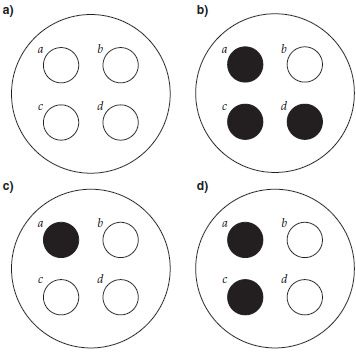
In each case the medium was minimal, with just a trace of substance X, to allow a small amount of growth of the mutant cells. On plate a , cells of mutant strain a were spread over the entire surface of the agar and grewto form a thin lawn (continuous bacterial growth overthe plate). On plate b , the lawn was composed of mutant b cells, and so on. On each plate, cells of the four mutanttypes were inoculated over the lawn, as indicated by thecircles. Dark circles indicate luxuriant growth. This experimenttests whether the bacterial strain spread on theplate can feed the four strains inoculated on the plate, allowing them to grow. What do these results show about the relationship of the four mutants to the metabolic pathway leading to substance X?

In each case the medium was minimal, with just a trace of substance X, to allow a small amount of growth of the mutant cells. On plate a , cells of mutant strain a were spread over the entire surface of the agar and grewto form a thin lawn (continuous bacterial growth overthe plate). On plate b , the lawn was composed of mutant b cells, and so on. On each plate, cells of the four mutanttypes were inoculated over the lawn, as indicated by thecircles. Dark circles indicate luxuriant growth. This experimenttests whether the bacterial strain spread on theplate can feed the four strains inoculated on the plate, allowing them to grow. What do these results show about the relationship of the four mutants to the metabolic pathway leading to substance X?

Unlock Deck
Unlock for access to all 33 flashcards in this deck.
Unlock Deck
k this deck
12
Wax moths can be cultured by allowing adult females to lay their eggs onto an artificial medium. The eggs hatch into larvae and, as they eat the medium, the larvae grow and molt through several larval stages. After the larval period, the animals enter a pupal stage during which they metamorphose into an adult moth. Two independently isolated moth mutants, rose-1 and rose-2, have eyes that are rose colored instead of the normal dark-red color. When rose-1 adults are ground up, mixed with artificial medium, and fed to rose-2 larvae, moths with darkred eyes are produced. However, when rose-2 adults are ground up, mixed with artificial medium, and fed to rose-1 larvae, the resulting moths have rose-colored eyes. Propose a hypothesis to explain these results.

Unlock Deck
Unlock for access to all 33 flashcards in this deck.
Unlock Deck
k this deck
13
The following growth responses (where growth and 0 no growth) of mutants 1-4 were seen on the related biosynthetic intermediates A, B, C, D, and E: 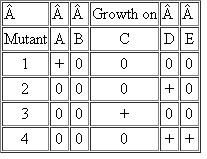 Assume that all intermediates are able to enter the cell, that each mutant carries only one mutation, and that all mutants affect steps after B in the pathway. Which of the following schemes best fits the data with regard to the biosynthetic pathway?
Assume that all intermediates are able to enter the cell, that each mutant carries only one mutation, and that all mutants affect steps after B in the pathway. Which of the following schemes best fits the data with regard to the biosynthetic pathway? 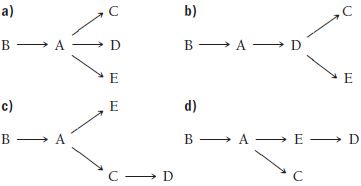
 Assume that all intermediates are able to enter the cell, that each mutant carries only one mutation, and that all mutants affect steps after B in the pathway. Which of the following schemes best fits the data with regard to the biosynthetic pathway?
Assume that all intermediates are able to enter the cell, that each mutant carries only one mutation, and that all mutants affect steps after B in the pathway. Which of the following schemes best fits the data with regard to the biosynthetic pathway? 

Unlock Deck
Unlock for access to all 33 flashcards in this deck.
Unlock Deck
k this deck
14
A Neurospora mutant has been isolated in the laboratory where you are working. This mutant cannot make an amino acid we will call Y. Wild-type Neurospora cells make Y from a cellular product X through a biochemicalpathway involving three intermediates called c,d, and e. How would you demonstrate that your mutantcontains a defective gene for the enzyme that catalyzes the d ? e reaction?

Unlock Deck
Unlock for access to all 33 flashcards in this deck.
Unlock Deck
k this deck
15
In Neurospora crassa , the amino acid lysine can be synthesized using either of two completely independent pathways. One pathway uses aspartate as an initial precursor, while the other uses
ketoglutarate. Four biochemical intermediates in the
ketoglutarate-initiated pathway are
aminoadipate, homocitrate,
aminoadipate semialdehyde, and saccharopine. Precisely describe the experiments you would carry out to answer each of the following questions.
a. How would you obtain lysine auxotrophs in Neurospora crassa ?
b. Can a lysine auxotrophic strain be blocked in just one of the two biosynthetic pathways for lysine?
c. How would you determine the order of the four intermediates used in the
ketoglutarate-initiated pathway?
ketoglutarate. Four biochemical intermediates in the
ketoglutarate-initiated pathway are
aminoadipate, homocitrate,
aminoadipate semialdehyde, and saccharopine. Precisely describe the experiments you would carry out to answer each of the following questions.
a. How would you obtain lysine auxotrophs in Neurospora crassa ?
b. Can a lysine auxotrophic strain be blocked in just one of the two biosynthetic pathways for lysine?
c. How would you determine the order of the four intermediates used in the
ketoglutarate-initiated pathway?

Unlock Deck
Unlock for access to all 33 flashcards in this deck.
Unlock Deck
k this deck
16
Upon learning that the diseases listed in the following table are caused by a missing enzyme activity, a medical student proposes the therapies shown in the rightmost column: 
a. Explain why each of the proposed therapies will be ineffective in treating the associated disease. For which disease would symptoms worsen if the proposed therapy were followed?
b. Vitamin D-dependent ricketts results in muscle and bone loss and is caused by a deficiency oF25-hydroxycholecalciferal 1 hydroxylase, an enzyme that catalyzes the formation of 1,25-dihydroxycholecalciferol (vitamin D) from 25-hydroxycholecalciferol. Unlike any of the situations in part (a), for this condition patients can be effectively treated by daily administration of the product of the enzymatic reaction, 1,25-dihydroxycholecalciferol (vitamin D). If you assayed for levels of serum 25-hydroxycholecalciferol in patients, what would you expect to find? Why is treatment with the product of the enzymatic reaction effective here, but not in the situations described in part (a)?

a. Explain why each of the proposed therapies will be ineffective in treating the associated disease. For which disease would symptoms worsen if the proposed therapy were followed?
b. Vitamin D-dependent ricketts results in muscle and bone loss and is caused by a deficiency oF25-hydroxycholecalciferal 1 hydroxylase, an enzyme that catalyzes the formation of 1,25-dihydroxycholecalciferol (vitamin D) from 25-hydroxycholecalciferol. Unlike any of the situations in part (a), for this condition patients can be effectively treated by daily administration of the product of the enzymatic reaction, 1,25-dihydroxycholecalciferol (vitamin D). If you assayed for levels of serum 25-hydroxycholecalciferol in patients, what would you expect to find? Why is treatment with the product of the enzymatic reaction effective here, but not in the situations described in part (a)?

Unlock Deck
Unlock for access to all 33 flashcards in this deck.
Unlock Deck
k this deck
17
Two couples in which both partners have albinism each have three children. All of the first couple's children likewise have albinism, while all of the second couple's children have normal pigmentation. How can you explain these findings?

Unlock Deck
Unlock for access to all 33 flashcards in this deck.
Unlock Deck
k this deck
18
Glutathione (GSH) is important for a number of biological functions, including the prevention of oxidative damage in red blood cells, the synthesis of deoxyribonucleotides from ribonucleotides, the transport of some amino acids into cells, and the maintenance of protein conformation. Mutations that have lowered levels of glutathione synthetase (GSS), a key enzyme in the synthesis of glutathione, result in one of two clinically distinguishable disorders. The severe form is characterized by massive urinary excretion of 5-oxoproline (a chemical derived from a synthetic precursor to glutathione), metabolic acidosis (an inability to regulate physiological pH appropriately), anemia, and central nervous system damage. The mild form is characterized solely by anemia. The characterization of GSS activity and the GSS protein in two affected patients, each with normal parents, is given in the following table: 
a. What pattern of inheritance do you expect these disorders to exhibit?
b. Explain the relationship of the form of the disease to the level of GSS activity.
c. How can two different amino acid substitutions lead to dramatically different phenotypes?
d. Why is 5-oxoproline produced in significant amounts only in the severe form of the disorder?
e. Is there evidence that the mutations causing the severe and mild forms of the disease are allelic (in the same gene)?
f. How might you design a test to aid in prenatal diagnosis of this disease?

a. What pattern of inheritance do you expect these disorders to exhibit?
b. Explain the relationship of the form of the disease to the level of GSS activity.
c. How can two different amino acid substitutions lead to dramatically different phenotypes?
d. Why is 5-oxoproline produced in significant amounts only in the severe form of the disorder?
e. Is there evidence that the mutations causing the severe and mild forms of the disease are allelic (in the same gene)?
f. How might you design a test to aid in prenatal diagnosis of this disease?

Unlock Deck
Unlock for access to all 33 flashcards in this deck.
Unlock Deck
k this deck
19
You have been introduced to the functions and levels of proteins and their organization. List as many protein functions as you can, and give an example of each.

Unlock Deck
Unlock for access to all 33 flashcards in this deck.
Unlock Deck
k this deck
20
We know that the function of any protein is tied to its structure. Give an example of how a disruption of a protein's structure by mutation can lead to a distinctive phenotypic effect.

Unlock Deck
Unlock for access to all 33 flashcards in this deck.
Unlock Deck
k this deck
21
The human
globin gene provides an excellent example of how the sequence of nucleotides in a gene is eventually expressed as a functional protein. Explain how mutations in the
globin gene can cause an altered phenotype. How can two different mutations in the same gene cause very different disease phenotypes?
globin gene provides an excellent example of how the sequence of nucleotides in a gene is eventually expressed as a functional protein. Explain how mutations in the
globin gene can cause an altered phenotype. How can two different mutations in the same gene cause very different disease phenotypes?

Unlock Deck
Unlock for access to all 33 flashcards in this deck.
Unlock Deck
k this deck
22
Consider the human hemoglobin variants shown in Figure. What would you expect the phenotype to be in people heterozygous for the following two hemoglobin mutations?
a. Hb Norfolk and Hb-S
b. Hb-C and Hb-S
Figure
Examples of amino acid substitutions found in (a) the 141-amino acid long -globin polypeptide and (b) the 146-amino acid -globin polypeptide of various human hemoglobin variants.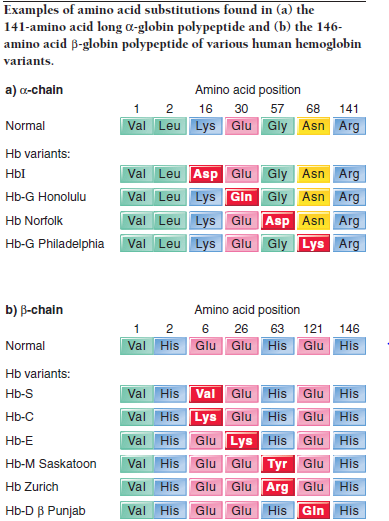
a. Hb Norfolk and Hb-S
b. Hb-C and Hb-S
Figure
Examples of amino acid substitutions found in (a) the 141-amino acid long -globin polypeptide and (b) the 146-amino acid -globin polypeptide of various human hemoglobin variants.


Unlock Deck
Unlock for access to all 33 flashcards in this deck.
Unlock Deck
k this deck
23
Tubulin and
tubulin are structural (nonenzymatic) proteins that polymerize together to form microtubules. In the nematode Canenorhabditis elegans , mutations in either of these proteins can result in recessive male sterility.
a. Generate a hypothesis to explain why the tubulin mutants are male-sterile.
b. What would you do to gather evidence to support your hypothesis?
tubulin are structural (nonenzymatic) proteins that polymerize together to form microtubules. In the nematode Canenorhabditis elegans , mutations in either of these proteins can result in recessive male sterility.
a. Generate a hypothesis to explain why the tubulin mutants are male-sterile.
b. What would you do to gather evidence to support your hypothesis?

Unlock Deck
Unlock for access to all 33 flashcards in this deck.
Unlock Deck
k this deck
24
Devise a rapid screen to detect new mutations in hemoglobin, and critically evaluate which types of mutations your screen can and cannot detect.

Unlock Deck
Unlock for access to all 33 flashcards in this deck.
Unlock Deck
k this deck
25
Glutamate oxaloacetic transaminase-2 (GOT-2) is a mitochondrial enzyme that synthesizes glutamate from aspartate and
ketoglutarate. GOT-2 is a homodimer-a protein made of paired identical polypeptides. The Got-2 M mutation introduces a single amino-acid change that alters the charge of the polypeptide produced by the normal Got-2 + allele. When enzymes from Got-2 + Got-2 + homozygotes, Got-2 + Got-2 M heterozygotes, and Got-2 M Got-2 M homozygotes are separated by charge using gel electrophoresis, the gel shows the following pattern of bands (thicker bands indicate more protein):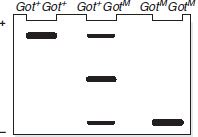
a. Compared to the normal GOT-2 polypeptide, is the polypeptide produced in Got-2 M Got-2 M mutants more basic or more acidic?
b. Explain the pattern and relative intensities of the bands seen in each Got-2 genotype.
c. Figure shows the pattern of bands seen when hemoglobin of individuals with sickle-cell trait is separated by charge using gel electrophoresis. Why do heterozygotes have only two types of hemoglobin, while Got-2 M Got-2 M heterozygotes have three types of GOT-2 protein?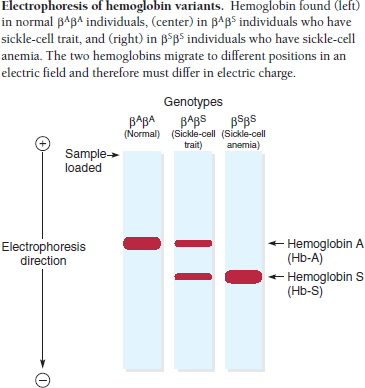
ketoglutarate. GOT-2 is a homodimer-a protein made of paired identical polypeptides. The Got-2 M mutation introduces a single amino-acid change that alters the charge of the polypeptide produced by the normal Got-2 + allele. When enzymes from Got-2 + Got-2 + homozygotes, Got-2 + Got-2 M heterozygotes, and Got-2 M Got-2 M homozygotes are separated by charge using gel electrophoresis, the gel shows the following pattern of bands (thicker bands indicate more protein):

a. Compared to the normal GOT-2 polypeptide, is the polypeptide produced in Got-2 M Got-2 M mutants more basic or more acidic?
b. Explain the pattern and relative intensities of the bands seen in each Got-2 genotype.
c. Figure shows the pattern of bands seen when hemoglobin of individuals with sickle-cell trait is separated by charge using gel electrophoresis. Why do heterozygotes have only two types of hemoglobin, while Got-2 M Got-2 M heterozygotes have three types of GOT-2 protein?


Unlock Deck
Unlock for access to all 33 flashcards in this deck.
Unlock Deck
k this deck
26
What is a mouse model for a human disease, and what is its utility?
b. What genetic and phenotypic properties would you require in a mouse model for Tay-Sachs disease?
c. How might a mouse model for Tay-Sachs disease be helpful in evaluating alternative therapeutic strategies.
b. What genetic and phenotypic properties would you require in a mouse model for Tay-Sachs disease?
c. How might a mouse model for Tay-Sachs disease be helpful in evaluating alternative therapeutic strategies.

Unlock Deck
Unlock for access to all 33 flashcards in this deck.
Unlock Deck
k this deck
27
What can prospective parents do to reduce the risk of bearing offspring who have genetically based enzyme deficiencies?

Unlock Deck
Unlock for access to all 33 flashcards in this deck.
Unlock Deck
k this deck
28
Some methods used to gather fetal material for prenatal diagnosis are invasive and therefore pose a small, but very real, risk to the fetus.
a. What specific risks and problems are associated with chorionic villus sampling and amniocentesis?
b. How are these risks balanced with the benefits of each procedure?
c. Fetal cells are reportedly present in the maternal bloodstream after about 8 weeks of pregnancy. However, the number of cells is very low, perhaps no more than one in several million maternal cells. To date, it has not been possible to isolate fetal cells from maternal blood in sufficient quantities for routine genetic analysis. If the problems associated with isolating fetal cells from maternal blood were overcome, and sufficiently sensitive methods were developed to perform genetic tests on a small number of cells, what would be the benefits of performing such tests on these fetal cells?
a. What specific risks and problems are associated with chorionic villus sampling and amniocentesis?
b. How are these risks balanced with the benefits of each procedure?
c. Fetal cells are reportedly present in the maternal bloodstream after about 8 weeks of pregnancy. However, the number of cells is very low, perhaps no more than one in several million maternal cells. To date, it has not been possible to isolate fetal cells from maternal blood in sufficient quantities for routine genetic analysis. If the problems associated with isolating fetal cells from maternal blood were overcome, and sufficiently sensitive methods were developed to perform genetic tests on a small number of cells, what would be the benefits of performing such tests on these fetal cells?

Unlock Deck
Unlock for access to all 33 flashcards in this deck.
Unlock Deck
k this deck
29
Many autosomal recessive mutations that cause disease in newborns can be diagnosed and treated. However, only a few inherited diseases are routinely tested for in newborns. Explore the basis upon which tests are performed by answering the following questions concerning testing for PKU, which is required on newborns throughout the United States, and testing for CF, which is done only if a newborn or infant shows symptoms consistent with a diagnosis of CF.
a. What are the relative frequencies of PKU and CF in newborns, and how-if at all-are these frequencies related to mandated testing?
b. What is the basis of the Guthrie test used for detecting PKU, and what features of the test make it useful for screening large numbers of newborns efficiently?
c. Multiple diagnostic tests have been developed for CF. Some are DNA-based while others indirectly assess CFTR protein function. An example of the latter is a test that measures salt levels in sweat. In CF patients, salt levels are elevated due to diminished CFTR protein function. Although the ?F508 mutation discussed in the text is common in patients with a severe form of CF, other CF mutations are associated with less severe phenotypes. Tests assessing CFTR protein function may not reliably distinguish normal newborns from newborns with mild forms of CF. What challenges do the types of available tests and the range of disease phenotypes present in a population pose for implementing diagnostic testing?
d. Discuss the importance of testing for PKU and CF at birth relative to the time that therapeutic intervention is required. Under what circumstances is testing newborns for CF warranted?
a. What are the relative frequencies of PKU and CF in newborns, and how-if at all-are these frequencies related to mandated testing?
b. What is the basis of the Guthrie test used for detecting PKU, and what features of the test make it useful for screening large numbers of newborns efficiently?
c. Multiple diagnostic tests have been developed for CF. Some are DNA-based while others indirectly assess CFTR protein function. An example of the latter is a test that measures salt levels in sweat. In CF patients, salt levels are elevated due to diminished CFTR protein function. Although the ?F508 mutation discussed in the text is common in patients with a severe form of CF, other CF mutations are associated with less severe phenotypes. Tests assessing CFTR protein function may not reliably distinguish normal newborns from newborns with mild forms of CF. What challenges do the types of available tests and the range of disease phenotypes present in a population pose for implementing diagnostic testing?
d. Discuss the importance of testing for PKU and CF at birth relative to the time that therapeutic intervention is required. Under what circumstances is testing newborns for CF warranted?

Unlock Deck
Unlock for access to all 33 flashcards in this deck.
Unlock Deck
k this deck
30
Reflecting on your answers to Question.29, state why newborns are not routinely tested for recessive mutations that cause uncurable diseases such as Tay-Sachs disease.

Unlock Deck
Unlock for access to all 33 flashcards in this deck.
Unlock Deck
k this deck
31
and Mrs. Chavez have a son who was found to have PKU at birth. Mr. and Mrs. Lieberman have a son who developed Tay-Sachs disease at about 7 months of age. Each couple is now expecting a second child, is concerned that their second child might develop the disease seen in their son, and so discusses their situation with a genetic counselor. After taking their family histories, the counselor describes a set of tests that can provide information about whether the second child will develop disease.
a. What different types of tests can be done to aid in carrier detection and fetal analysis, and what are their advantages and disadvantages?
b. How would you determine whether the disease see in each couple's son results from a new mutation or has been transmitted from one or both of the parents?
c. Place yourself in each couple's predicament. Would you ask that fetal analysis be performed in each situation? Explain your reasoning.
a. What different types of tests can be done to aid in carrier detection and fetal analysis, and what are their advantages and disadvantages?
b. How would you determine whether the disease see in each couple's son results from a new mutation or has been transmitted from one or both of the parents?
c. Place yourself in each couple's predicament. Would you ask that fetal analysis be performed in each situation? Explain your reasoning.

Unlock Deck
Unlock for access to all 33 flashcards in this deck.
Unlock Deck
k this deck
32
Neuronal development has essentially ceased by the time humans reach their early twenties. Why then are all women with PKU who become pregnant, including women over 25, advised to return to a phenylalanine-restricted diet throughout their pregnancy?

Unlock Deck
Unlock for access to all 33 flashcards in this deck.
Unlock Deck
k this deck
33
In evaluating my teacher, my sincere opinion is that
a. he or she is a swell person whom I would be glad to have as a brother-in-law or sister-in-law.
b. he or she is an excellent example of how tough it is when you do not have either genetics or environment going for you.
c. he or she must be missing a critical enzyme and is accumulating some behavior-altering intermediate.
d. he or she ought to be preserved in tissue culture for the benefit of other generations.
a. he or she is a swell person whom I would be glad to have as a brother-in-law or sister-in-law.
b. he or she is an excellent example of how tough it is when you do not have either genetics or environment going for you.
c. he or she must be missing a critical enzyme and is accumulating some behavior-altering intermediate.
d. he or she ought to be preserved in tissue culture for the benefit of other generations.

Unlock Deck
Unlock for access to all 33 flashcards in this deck.
Unlock Deck
k this deck



